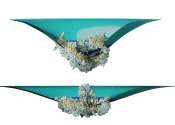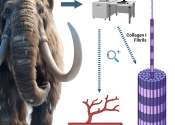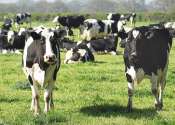Last update:
Biology news

Smart guide RNAs: Researchers use logic gate-based decision-making to construct circuits that control genes
Researchers have transformed guide RNAs, which direct enzymes, into a smart RNA capable of controlling networks in response to various signals. A research team consisting of Professor Jongmin Kim and Ph.D. candidates Hansol ...
Biotechnology
33 minutes ago
0
0

Heat-sensitive trees moving uphill due to rising temperatures, study finds
Trees in the Brazilian Atlantic Forest are migrating in search of more favorable temperatures, with species in mountain forests moving uphill to escape rising heat caused by climate change, a new study reveals.
Plants & Animals
38 minutes ago
0
0

Cocaine found in muscle and liver of sharpnose sharks off coast of Rio de Janeiro
A team of marine biologists and ecotoxicologists affiliated with several institutions in Brazil has found cocaine in muscle and liver samples collected from Brazilian Sharpnose sharks harvested off the coast of Rio de Janeiro. ...

New rapid method for determining virus infectivity
A new method that can rapidly determine whether a virus is infectious or non-infectious could revolutionize the response to future pandemics.
Molecular & Computational biology
6 hours ago
0
23

Off Ecuador's Galapagos, a former shark-poaching ship's new mission
When Ecuador's navy seized a Chinese-flagged ship off the Galapagos Islands in 2017, its hold brimmed with tons and tons of poached fish, many of them threatened species like hammerhead and thresher sharks.
Ecology
5 hours ago
0
0

Discovery of Piezo1's new signaling mechanism may aid search for better pain and itch treatments
The human body's sense of touch is so important it can be found throughout the body, not just on the skin. Two tiny sensors of touch, Piezo1 and Piezo2, signal the lightest pressures and can be found monitoring the circulatory ...
Cell & Microbiology
17 hours ago
0
18

Ciliated eukaryotes study offers simple, versatile method for tubulin staining
Ciliates, a group of single-celled ciliated eukaryotes, have been studied since the dawn of light microscopy, with over 10,000 species described. Cilia are the key feature of ciliates and contribute to their diversity. They ...
Cell & Microbiology
18 hours ago
0
48

Nanoscopic imaging aids in understanding protein, tissue preservation in ancient bones
A pilot study from North Carolina State University shows that nanoscopic 3D imaging of ancient bone not only provides further insight into the changes soft tissues undergo during fossilization, it also has potential as a ...
Biotechnology
19 hours ago
0
79

Octopus and squid pigments enhance sunscreen without harming the environment, researchers say
When Northeastern graduate Camille Martin and associate professor Leila Deravi co-founded Seaspire, a skincare ingredients company inspired by pigment in octopus and squid, their goal was to create a product that is good ...
Biotechnology
21 hours ago
0
152

Team develops a technique to detect nutrients in soil faster and more affordably
Every year, Missouri farmers lose millions of dollars in valuable nutrients that wash away into rivers and lakes. These nutrients—nitrates and phosphates found in fertilizers—are crucial for plant growth, but they wreak ...
Biotechnology
20 hours ago
0
20

Understanding how a red seaweed reduces methane emissions from cows
Methane is the second-largest contributor to climate warming after carbon dioxide, and so scientists have put a lot of attention toward addressing one of the top sources: methane emissions from livestock. In other words, ...
Cell & Microbiology
22 hours ago
0
55

Chimpanzees gesture back and forth quickly like in human conversations, researchers find
When people are having a conversation, they rapidly take turns speaking and sometimes even interrupt. Now, researchers who have collected the largest ever dataset of chimpanzee "conversations" have found that they communicate ...
Plants & Animals
23 hours ago
0
2

Q&A: How machine learning is propelling structural biology
For Lucas Farnung, there is no question more fascinating than how a single fertilized egg develops into a fully-functioning human. As a structural biologist, he is studying this process on the smallest scale: the trillions ...
Cell & Microbiology
17 hours ago
0
33

Sustainable management and regeneration of endangered Senegalia venosa needed in Ethiopia, says study
A research team has identified the distribution and regeneration status of the endangered Senegalia venosa in Tigray and Gonder drylands. They found it has a poor regeneration rate due to factors like charcoal production ...
Plants & Animals
17 hours ago
0
47

Comprehensive evaluation identifies top finger lime varieties for commercial and ornamental use
A research team has conducted a comprehensive evaluation of nine finger lime varieties, identifying key differences in fruit peel color and suitability for commercial production. Xiangbinhong emerged as the best variety for ...
Molecular & Computational biology
17 hours ago
0
1

Using forest resources strengthens food security, study finds
Forests can reduce hunger in rural households while also capturing carbon and advancing sustainability goals for low- and middle-income countries, according to new research by University of Notre Dame experts.
Ecology
17 hours ago
0
24

Insect pests study finds public surveillance is critical to early detection
A new study from the University of Maryland identifies key patterns and factors influencing insect pest establishment and detection across the U.S. and suggests public surveillance awareness and involvement is a critical ...
Ecology
19 hours ago
0
1

Not everything that tastes bitter is potentially harmful—but why?
A bitter taste is traditionally considered a warning sign of potentially toxic substances. But not all bitter substances are harmful. For example, some peptides and free amino acids taste bitter, even though they are non-toxic, ...
Molecular & Computational biology
21 hours ago
0
1

Birds need entertainment during avian flu lockdowns
Scientists have studied a flock of Chilean flamingos that were kept indoors due to a government order to stop the spread of avian influenza and found that birds need varied activities during avian flu lockdowns.
Ecology
21 hours ago
0
1

Ecologists discover rare fiddler crab species on Hong Kong coast
Researchers from the School of Biological Sciences (SBS) and the Swire Institute of Marine Science (SWIMS) at The University of Hong Kong (HKU), in collaboration with National Chung Hsing University, have made an exciting ...
Plants & Animals
21 hours ago
0
0
More news

Transient structure in fly leg holds clue to insect shape formation

It's not just humans—bacteria also have memory, study suggests

Researchers work to change perception of weeds in Georgia

Genetic breeding offers new method for mosquito population control

Scientists uncover fundamental rules for how dengue virus infects its mosquito and human hosts

New genetic test can help eliminate a form of inherited blindness in dogs
Other news

Nature-inspired novel catalyst paves the way for efficient hydrocarbon decomposition

Chinese lunar probe finds water in moon samples

Expiring medications could pose challenge on long space missions

'New El Niño' discovered south of the equator

New technique streamlines synthesis of heavy element compounds

Study deciphers intricate 3D structure of DNA aptamer for disease theranostics

Researchers develop first voxel building blocks for 3D-printed organs
























































